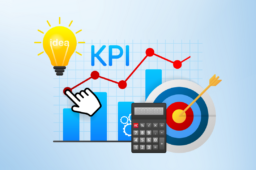
How to Use KPIs to Measure Project Success?
- September 24, 2024
- by
- tehreem
Every project manager faces the challenge of ensuring that their projects succeed. Yet, measuring project success is not always straightforward. This is where Key Performance Indicators (KPIs) come in. KPIs offer measurable values that demonstrate how effectively a project is achieving key business objectives.
Imagine working on a project without any tangible way to track its progress. Frustrating, right? KPIs help solve this problem by giving project managers a clear roadmap of where the project stands at any given moment. In this blog, we’ll walk through the importance of KPIs and how they can be used to measure project success.
Understanding Project Success: What Does It Mean?
Before diving into KPIs, it’s important to define what project success means. Success is often determined by how well the project meets its deliverables, adheres to the budget, and finishes on time. But it goes beyond that; success also includes delivering a high-quality product that satisfies stakeholders’ expectations. It’s vital to ensure that the KPIs you set are aligned with the specific goals of the project and contribute to its overall success.
Why Are KPIs Important for Measuring Project Success?
KPIs are essential for measuring project success because they provide concrete data points to evaluate progress. By tracking KPIs throughout the project lifecycle, project managers can identify areas of strength and where improvement is needed. For example, if a project consistently lags in resource allocation, this KPI will highlight the issue, allowing managers to make informed decisions for optimization.
Additionally, KPIs serve as a tool for communicating project health to stakeholders. They offer clear, measurable indicators that everyone can understand, ensuring that the project stays on track and aligned with overall business objectives.
How to Choose the Right KPIs for Your Project
Not all KPIs are created equal. Choosing the right KPIs for your project requires careful consideration of several factors. Here’s how you can ensure that your KPIs drive project success:
1. Align KPIs with Project Goals
Your KPIs should be directly aligned with the goals of the project. For instance, if the goal is to increase customer satisfaction, then setting KPIs related to client feedback or NPS (Net Promoter Score) is critical.
2. Keep KPIs Simple and Actionable
Complex KPIs can become overwhelming. Stick to KPIs that are easy to understand and actionable. Simplicity in measurement leads to better decision-making.
3. Measure KPIs Regularly
KPIs aren’t a “set it and forget it” kind of tool. Regular measurement and review are essential to track project success. Frequent monitoring allows teams to make adjustments as necessary to stay on course.
Types of KPIs to Measure Project Success
There are various types of KPIs to measure different aspects of project success. Let’s explore some common categories:
1. Timeliness KPIs
These track whether the project is staying on schedule. A commonly used timeliness KPI is the on-time completion rate, which measures how many tasks are completed on time against the overall project timeline.
2. Budget KPIs
Budget KPIs focus on cost control. The cost variance KPI, for example, compares the budgeted cost of work with the actual cost incurred, providing a clear picture of whether the project is on or off budget.
3. Quality KPIs
Ensuring the quality of deliverables is key to project success. KPIs like the defect density rate can help measure the number of defects in a product or service, ensuring that the project maintains high standards.
4. Customer Satisfaction KPIs
Satisfying your stakeholders is a critical marker of success. KPIs such as the customer satisfaction score (CSAT) or Net Promoter Score (NPS) can gauge how well the project’s outcomes are received by the client.
5. Resource Allocation KPIs
Efficient use of resources is a key indicator of project health. KPIs like the resource utilization rate can measure how effectively resources like manpower and materials are being deployed.
Using KPI Dashboards to Track Project Success
Once you’ve identified the right KPIs, the next step is to track them effectively. This is where KPI dashboards come into play. Dashboards allow project managers to visualize KPIs in real time, making it easier to spot trends and potential risks early. Tools such as ClearPoint Strategy or Hive offer customizable dashboards that enable teams to track performance metrics at a glance. For instance, with real-time KPI monitoring, project managers can act quickly on any variances from the plan.
Common Mistakes When Using KPIs
Tracking KPIs can significantly enhance project success, but there are common pitfalls to avoid:
- Tracking Too Many KPIs: Overloading your dashboard with too many KPIs dilutes focus. Stick to a few key metrics that directly impact project outcomes.
- Selecting Irrelevant Metrics: KPIs should be relevant to your project’s goals. Avoid choosing KPIs that do not align with what success looks like for your particular project.
- Failing to Act on KPI Data: KPIs are useless unless acted upon. Use KPI insights to make strategic adjustments throughout the project.
Successful Use of KPIs in a Project
Imagine a software development company that set timeliness KPIs such as sprint velocity and quality KPIs like defect density. By regularly tracking these metrics, the company could adjust its resource allocation and streamline its development process. As a result, the project was completed on time, within budget, and exceeded client expectations in terms of quality.
FAQs on Using KPIs to Measure Project Success
Q1. What are the most important KPIs for project success?
The most important KPIs often include time-related KPIs (e.g., on-time completion rate), budget-related KPIs (e.g., cost variance), and quality KPIs (e.g., defect rate).
Q2. How do I know if my KPIs are effective?
Effective KPIs are directly linked to project goals, are easy to measure, and provide actionable insights.
Q3. Can KPIs be adjusted during a project?
Yes, KPIs can and should be adjusted as the project progresses and new information arises.
Q4. How often should KPIs be reviewed?
KPIs should be reviewed regularly, often at key project milestones or during monthly status meetings.
Using KPIs to measure project success ensures that project managers can track progress, adjust strategies, and communicate effectively with stakeholders. By carefully selecting and monitoring the right KPIs, you’ll set your projects up for success, leading to better outcomes and happier clients. Ready to start tracking? Begin with the right tools and strategies, and watch your project flourish.






